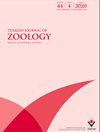评估图尔基耶一个保护完好的自然公园中 Pelophylax bedriagae caralitanus 的种群数量和存活率
IF 1.3
4区 生物学
Q2 ZOOLOGY
引用次数: 0
摘要
:估计种群趋势为保护生物学家提供了宝贵的信息。尽管估算人口统计率的方法有很多,但众所周知,捕获-标记-再捕获(CMR)方法是最现实的方法,可以提供个体和种群的详细数据,包括实现保护目标的情况。本研究的重点是利用CMR方法确定2011-2019年繁殖季节保护区内贝西希尔蛙(Pelophylax bedriagae caralitanus)的种群趋势。我们的CMR数据使我们在22个构建的模型中选择了一个考虑了恒定存活率、捕获/再捕获概率和特定年份移民/迁徙模式的模型[Φ(--) y'(t) y''(t) p(--) = c(--) N(t) ]--作为最拟合的生物学假说。根据最佳拟合模型,每次采样都能捕获格尔库克种群中 6% 的个体。年存活率在不同年份之间的变化较小,平均存活率估计为 0.85,即 Gölcük 种群中 85% 的 Pelophylax bedriagae caralitanus 个体能够存活到以后的繁殖季节。Gölcük种群连续9年的平均种群数量估计为5094(范围为4834-5382)只,这表明种群数量波动较小且在可接受的范围内,并且逐年略有增加。这些发现可以指导未来的研究,有助于评估保护区和非保护区的种群数量变化,同时了解种群数量下降的趋势。本文章由计算机程序翻译,如有差异,请以英文原文为准。
Assessing population size and survival rate of Pelophylax bedriagae caralitanus, in a well-protected Nature Park in Türkiye
: Estimating population trends provides valuable information for conservation biologists. Although there are many methods for estimating demographic rates, capture-mark-recapture (CMR) methods are known to be the most realistic method that can provide detailed data on individuals and populations, including the achievement of conservation goals. This study focused on determining the population trend of Pelophylax bedriagae caralitanus, Beyşehir frog using the CMR method in a protected area during the 2011–2019 breeding seasons. Our CMR data led to the selection of model-considering constant survival rates, capture/recapture probabilities, and year-specific immigration/emigration patterns [ Φ(··) y’(t) y’’(t) p(··) = c(··) N(t) ]-as the most fitting biological hypothesis among 22 constructed models. According to the best-fitted model, 6% of all individuals in Gölcük population can be captured during each sampling occasion. The annual survival rates show low variation between years, and the mean survival rate was estimated as 0.85, that means 85% of the individuals of Pelophylax bedriagae caralitanus in the Gölcük population were able to live on to subsequent breeding seasons. The average population size of Gölcük population for nine consecutive years was estimated as 5094 (range 4834–5382) individuals that shows minor and acceptable levels of population size fluctuations, and slightly increasing over the years. These findings can guide future research, aiding in assessing population size changes in both protected and nonprotected areas while understanding population decline trends.
求助全文
通过发布文献求助,成功后即可免费获取论文全文。
去求助
来源期刊

Turkish Journal of Zoology
ZOOLOGY-
CiteScore
2.30
自引率
10.00%
发文量
24
审稿时长
6-12 weeks
期刊介绍:
The Turkish Journal of Zoology is published electronically 6 times a year by the Scientific and Technological Research Council of Turkey (TÜBİTAK).
-Accepts English-language manuscripts in various fields of zoology including systematics, developmental biology, behaviour biology, animal models, molecular biology and molecular phylogeny, genomics, physiology (cell communication and signaling systems), biochemistry and immunohistochemistry, applied parasitology and pathology, nanobiotechnology, ecology, evolution, and paleontology of animal taxa.
-Contribution is open to researchers of all nationalities.
-Short communications are also welcome, such as reports of a preliminary nature or those including new records from specific localities or regions, and the editor reserves the right to decide that a paper be treated as a short communication.
-The papers that deal with purely checklists, new host and non-regional new locality records will not be consider for publication.
-Letters to the editor reflect the opinions of other researchers on the articles published in the journal. The editor may also invite review articles concerning recent developments in particular areas of interest.
 求助内容:
求助内容: 应助结果提醒方式:
应助结果提醒方式:


